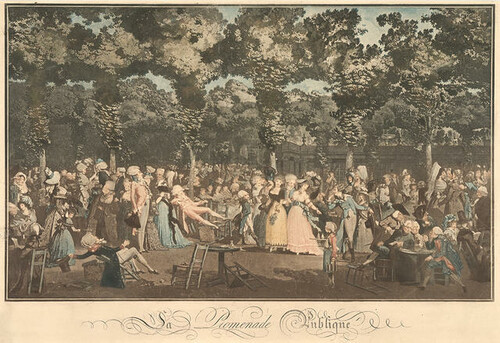B.
La promenade publique by Philibert-Louis Debucourt
Collection
This article first appeared as 'Aristocrats at play' in The Press on 14 April 2015.
This coloured aquatint was published in Paris in the first half of 1792. The second half of the same year saw riots, the massacre of the Kings's Swiss Guards, the descent into chaos of the Legislative Assembly, foreign invasion, the abolition of the monarchy and with that the abolition of the year itself: 22 September 1792 became day one of month one of year one of the Republican Calendar. Philippe Debucourt's 'La Promenade Publique' shows the aristocrats at play before the revolution erupted: dancing, gambling and gossiping. Look closely though and there are warning signs that the party is about to turn very nasty indeed.
It is likely that Debucourt drew inspiration for this print from Thomas Rowlandson's depiction of the Vauxhall Gardens. Both show recognizable people and buyers of the print would find it amusing to identify who was who and what behaviours and affectations were being caricatured. It was a commercial success for its cretaor Philippe Debucourt.
The scene shows well-to-do Parisians at leisure. Several characters appear to be drunk and furniture has been carelessly knocked over. Yellow waistcoats, wigs, ribbons and laces are everywhere. The man in the centre is, with obvious symbolism, needlessly occupying more than one chair. The trio to the right seem to be plotting and may well be lawyers or moneylenders – managing, financing and thus profiting from all this frivolity.
The giddy scene is bathed in sunlight but in the foreground is deep shadow. Standing in that shadow is the central character of the composition, the boy with the tray of food.
Except it is not food, at least not in the sense of vital sustenance. It appears to be some kind of sweetmeat, perhaps even ice cream. And this in a country where successive bad harvests have caused starvation, food riots, and, supposedly, a comment from the queen that cake might do just as well as bread.
And while the aristocrats are all in motion, sauntering, gesturing, flirting and indeed falling over, the boy stands stock still with a back as straight as the little boy being asked when he last saw his father. His is the only face that we cannot see but we know that he is gazing intently at the scene of profligacy and superficiality before him. The partying aristocrats wear all colours including pastel pinks and yellows. If you include the metallic blue of the food container, the boy's colour scheme is revolutionary red, white and blue. Four colour aquatint was a French invention from the 1770s. It is used here very nicely to make both a decorative and a political point.
So while the figure of a servant boy looks on the nobles lark around recklessly, consuming what they had not earned, spending what they could not afford. Within months, the tables would be radically turned. As critic Malcolm Salaman put it in his book on Debucourt: these people 'had yet to hear the thud of a head falling into a basket'. Within months, they would.

